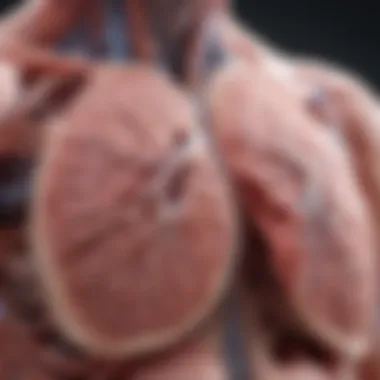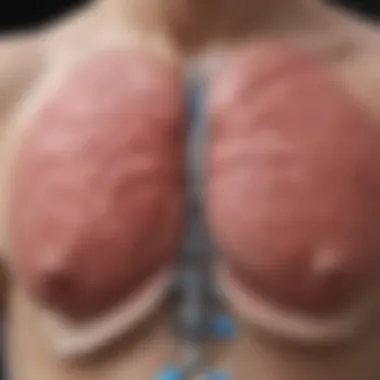A Detailed Guide to Mild Biapical Pleural Thickening


Intro
Mild biapical pleural thickening might not be the most prevalent term in medical conversations, yet it carries a significant weight in the landscape of thoracic health. The pleura, being the thin membrane surrounding the lungs, plays an essential role in respiratory function. When examining the health of an individual, especially in relation to lung diseases, understanding any thickening of this membrane is critical. This article aims to peel back the layers of what mild biapical pleural thickening entails, why it occurs, and how it impacts patient health.
Research Overview
In delving into mild biapical pleural thickening, it’s important to set the groundwork—what has been found in recent studies?
Summary of Key Findings
Research indicates that the causes of mild biapical pleural thickening are varied. These can range from benign conditions such as past infections to more concerning issues like chronic inflammatory processes. Some noteworthy findings include the following:
- Asbestosis: Previous exposure to asbestos can often lead to pleural changes over time.
- Tuberculosis: A history of this infectious disease can result in scarring, contributing to thickening.
- Chronic Obstructive Pulmonary Disease (COPD): Patients suffering from this condition sometimes develop pleural thickening as a secondary effect.
Background and Context
The context behind mild biapical pleural thickening is shaped by historical cases and evolving diagnostic criteria. Such thickening is often discovered incidentally during imaging done for unrelated issues. Recent advancements in imaging modalities have made identifying such anomalies less laborious, yet interpretation of these findings necessitates a comprehensive understanding of potential etiologies. Additionally, awareness surrounding this condition has grown, partially due to rising instances of lung diseases that contribute to pleural changes.
Methodology
To solidify our understanding, analyzing methodological approaches used in recent studies can provide insight into how data regarding this condition is gathered and interpreted.
Experimental Design
Most studies utilize a retrospective design, analyzing medical records of patients who have presented with chest imaging studies. This method allows researchers to track the presence of thickening over time and correlate it with clinical outcomes.
Data Collection Techniques
Data is generally collected through various imaging techniques, predominantly through:
- Chest X-rays: Often the first line of investigation.
- CT Scans: Provides a more detailed view of the pleura, highlighting changes that are not visible in X-rays.
By utilizing these methodologies, researchers can effectively analyze the prevalence, etiology, and implications of mild biapical pleural thickening, paving the way for further understanding in the medical community.
Preamble to Pleural Thickening
Mild biapical pleural thickening serves as a reminder of the complexities surrounding lung health. The pleura, a sensitive tissue, can undergo numerous changes due to various factors, leading to thickening that reflects more than just anatomical modification. Gaining insight into the phenomena surrounding pleural thickening is crucial for students, researchers, and healthcare professionals alike. This understanding is not merely academic; it has real-world implications for patient diagnosis, treatment planning, and ongoing health management.
When we discuss pleural thickening, it often conjures images of deeper medical conditions. However, there’s more than meets the eye. Understanding why and how the pleura becomes thickened can help in deciphering broader aspects of patient care. Knowing its relevance can lead to better patient outcomes, guiding decisions based on the health status of the lung parenchyma. Hence, this article aims to clarify the purpose of studying mild biapical pleural thickening while shedding light on the importance of early identification of pleural changes.
Defining the Pleura
The pleura is a dual-layered membrane enveloping the lungs. This membranous structure consists of two parts: the visceral pleura, which covers the lungs, and the parietal pleura, which lines the chest wall. The pleura has several crucial functions, including:
- Offering a smooth surface for lung movements during respiration.
- Secreting pleural fluid that lubricates the space between the layers, facilitating expansion and contraction.
- Acting as a barrier against infections and foreign substances.
When the pleura experiences thickening primarily at the apices of the lungs, it often indicates underlying conditions or responses to external irritants.
Overview of Pleural Thickening
Pleural thickening is generally categorized into different levels of severity, with "mild" being a specific term often used in clinical contexts. The process of thickening can arise due to various stimuli, often resulting in a fibrotic response. Understanding the nature of this thickening is essential in light of the diverse etiological factors that influence lung health, ranging from infectious processes to chronic disease.
Mild biapical pleural thickening is characterized by subtle, yet noteworthy, changes seen on imaging studies. These changes may not denote immediate pathological significance, but they serve as important indicators of lung condition over time.
This emphasizes the need for thorough assessment, as early findings can be critical in preventing disease progression in at-risk patients.


Overall, recognizing the implications of pleural thickening can lead healthcare providers to adopt a proactive approach in monitoring and managing respiratory health.
Mild biapical pleural thickening is a significant clinical phenomenon that often goes under the radar yet plays a vital role in respiratory health. Understanding this condition is not just about recognizing the images on a scan; it’s about grasping its implications on lung function, potential underlying causes, and the appropriate management strategies. This understanding aids healthcare professionals in making informed decisions, thereby improving patient outcomes.
Pathophysiology of Mild Biapical Pleural Thickening
The pathophysiology of mild biapical pleural thickening is multifaceted. At its core, pleural thickening refers to the suggestive structural changes in the pleural membrane—the tissue that envelops the lungs. When thickening occurs at the apices of both lungs, several aspects come into play. One prominent feature is that inflammation may trigger fibroelastic tissue formation in the pleura, leading to a thickened appearance. This often happens in response to various stimuli, such as infections, chronic inflammatory processes, and even benign conditions.
Furthermore, it is crucial to understand how regional differences in circulation play a role. The apex of the lungs receives less blood flow compared to the lower regions; when there’s any compromise in lung function or perfusion, you may see changes appearing here. The pleura may become fibrotic, creating a lasting impact on respiratory mechanics. Overall, grasping these underlying mechanisms helps frame the clinical picture and guides subsequent evaluations and interventions.
Clinical Presentation
Clinically, mild biapical pleural thickening may present subtly. Many patients remain asymptomatic despite radiological findings. However, when symptoms manifest, they can typically include:
- Shortness of Breath: Patients may report feeling winded with minimal exertion. This can be particularly concerning as it could point to more extensive lung issues.
- Cough: An annoying tickling sensation or persistent cough may arise. It often correlates with underlying inflammatory processes.
- Chest Discomfort: While not universally reported, some individuals may describe a sensation of tightness or discomfort in the chest area.
To further complicate matters, the clinical picture can overlap with other conditions, making it essential to conduct thorough evaluations. A clinician should be well-versed in not just recognizing the signs but connecting the dots between pleural thickening and any respiratory symptoms that arise.
"Recognizing the clinical nuances of mild biapical pleural thickening is key in ensuring timely diagnosis and management of lung-related health issues."
Etiological Factors
Recognizing the etiological factors behind mild biapical pleural thickening is crucial for correctly diagnosing and managing the condition. The presence of thickened pleura at the lung apex can stem from a myriad of causes. Understanding these underlying factors helps healthcare professionals tailor treatment plans that address the root of the issue rather than merely alleviating symptoms. Here are some dimensions to consider about these factors:
- Multi-faceted nature: The etiological landscape is complex. Factors range from infectious agents to environmental exposures, each requiring distinct diagnostic approaches and interventions.
- Impact on health outcomes: Identifying the specific cause can influence the prognosis. Some causes may be benign, while others could lead to significant health complications.
- Awareness for prevention: Gaining insight into these factors can also aid in preventative measures, particularly for occupational exposures.
Infectious Causes
Infectious processes are often at the forefront when addressing pleural thickening. Bacterial infections, viral illnesses, and tuberculosis can lead to inflammation of the pleura, resulting in thickening. One classic example is tuberculosis, where the infection can cause a specific reaction in the pleura, significantly affecting lung function. If a patient presents with history of exposure or symptoms indicative of a respiratory infection, thorough investigation is required to rule out infectious etiologies.
Environmental Influences
Environmental factors can also play a monumental role in the development of pleural thickening. Air pollutants, such as asbestos fibers or particulate matter from industrial processes, have been closely linked to pleural disease. Exposure to these agents over time can induce a cascade of inflammatory responses leading to fibrosis (a thickening and stiffening) of the pleura. The rise of urban pollution necessitates a closer look at geographical trends and occupational hazards that might elevate risk levels in certain populations.
Occupational Risks
Several industries present a higher risk for developing pleural thickening due to the specific workplace exposures. For instance:
- Construction and demolition workers: Exposure to asbestos, a known carcinogen, can lead to serious pleural complications.
- Mining industry: Miners often encounter silica dust, leading to pneumoconiosis, which, among other complications, may result in pleural thickening.
- Manufacturing roles: Workers in plants that process chemicals may inhale hazardous materials that could trigger inflammatory responses in the lungs.
Regular health screenings and monitoring are paramount for individuals in these at-risk occupations to catch issues early on.
Systemic Diseases
Various systemic conditions can contribute to the development of mild biapical pleural thickening. Diseases like lupus and rheumatoid arthritis have been associated with pleural involvement. In these instances, the thickening can be less about direct lung injury and more about systemic inflammation impacting pleural membrane integrity. Understanding a patient's medical history, including autoimmune conditions, assists in providing adequate care and adjusting treatment modalities accordingly.
Ultimately, a thorough evaluation of etiological factors is not only essential for diagnosis but also plays a pivotal role in management of mild biapical pleural thickening. Thus, connecting clinical symptoms and patient history forms a critical part of crafting effective treatment strategies.
Diagnostic Approaches
Imaging Techniques
X-ray Analysis
X-ray analysis serves as the first line of defense in diagnosing pleural thickening. This method is widespread within clinical practice due to its accessibility and rapid execution. Unlike more complex imaging techniques, X-rays are quick and can be performed in various settings, often without requiring specialized equipment.
One key characteristic of X-ray analysis is its ability to provide a two-dimensional representation of the thoracic cavity. This is especially beneficial for identifying pleural thickening around the apices of the lungs. Moreover, it is cost-effective, making it an attractive choice for both hospitals and clinics.


However, X-ray analysis isn’t without its drawbacks. The resolution may not be sufficient to identify subtle changes, and overlapping structures can sometimes obscure important details. As a result, it may serve as a preliminary tool, prompting further investigation if abnormalities are detected.
CT Scan Evaluations
CT scan evaluations take imaging a step further by offering cross-sectional views of the chest, providing detailed insights that X-rays simply cannot. The high-resolution images produced by CT scans allow for a much more nuanced assessment of pleural thickening, revealing the extent of any thickening and potential underlying complications.
A significant advantage of CT scans is their capacity to differentiate between various types of pleural effusions and assess pleural nodules, should they be present. While more comprehensive, this imaging technique does come with some cons. The process is more time-consuming and typically exposes the patient to a higher dose of radiation than X-rays. Cost can also be a consideration, as CT scans are generally more expensive than traditional X-ray imaging.
Role of Histopathology
Histopathology plays a pivotal role in the diagnostic process. When imaging suggests the presence of mild biapical pleural thickening, a biopsy may be necessary to clarify the condition's nature. This analysis evaluates tissue samples critically, providing insights into cellular structures that might reveal underlying causes, be it inflammatory processes or neoplastic changes.
With histopathology, the understanding deepens significantly. It allows clinicians to discern between benign thickening due to scarring and potential malignant processes. This differentiation is vital, as it directly influences the management strategies employed.
In sum, the integration of various diagnostic approaches is key for navigating the complexities of mild biapical pleural thickening. Diagnostic imaging, complemented by histopathological assessments, codes a more intricate narrative of patient health.
Clinical Significance
Understanding the clinical significance of mild biapical pleural thickening goes beyond mere recognition of the condition; it delves into how this finding relates to respiratory health and overall patient care. This segment focuses on the implications that mild thickening of the pleura at the apex of both lungs can have on a patient's well-being, emphasizing the necessity for early detection and meticulous assessment.
Impacts on Respiratory Health
Mild biapical pleural thickening is frequently a marker of underlying thoracic issues. This condition can indicate a range of factors that might influence a patient's respiratory function. When the pleura thickens, it can limit the pleural space and potentially impact lung expansion. Patients might not always exhibit overt symptoms, but subtle changes in breathing patterns or an increased tendency to experience shortness of breath on exertion can develop.
Moreover, the thickening can lead to an increased risk of complications such as pleuritis or even respiratory infections. Chronic inflammation in this area suggests the need for continuous monitoring. Notably, pulmonary function tests could reveal a decrease in lung capacity related to this pleural condition, warranting an investigation into its cause.
In summary, while mild biapical pleural thickening might seem insignificant at first glance, its impact on respiratory health could be considerable. Therefore, it’s crucial for healthcare providers to assess patients thoroughly, educate them about potential symptoms to watch for, and provide tailored management strategies that cater to their specific needs.
Prognostic Considerations
The prognosis related to mild biapical pleural thickening depends on the underlying causes and associated risk factors. Identifying whether the thickening is linked to a benign condition or a more serious pathology plays a vital role in determining patient outcomes. For instance, if the thickening stems from chronic inflammatory conditions like fibrosis, the long-term management may include lifestyle adjustments and close follow-ups.
Conversely, if an infectious etiology is established, such as tuberculosis, it may necessitate more aggressive treatment modalities. Timing becomes crucial here; earlier interventions may lead to better prognostic outcomes, reducing the risk of complications associated with delayed diagnosis.
Patients should be counseled about what their findings mean in relation to their overall health. They should also undergo individual risk assessments for lung health, which could encompass factors such as age, history of smoking, occupational exposure, and other underlying health issues.
"The presence of mild biapical pleural thickening serves as an essential clue, alerting clinicians to potential underlying conditions and guiding further investigative pathways."
It’s vital for doctors to recognize that every case of mild biapical pleural thickening is unique, and thus, management should be as personalized as possible to ensure comprehensive care while maximizing patient safety.
Management and Treatment Options
When it comes to addressing mild biapical pleural thickening, management and treatment options take center stage. While the condition itself may not always present immediate threats to health, finding the right approach can significantly enhance a patient’s overall quality of life. Addressing this topic is critical for both healthcare practitioners and individuals experiencing symptoms, as it underlines not just intervention techniques but also monitoring strategies that play a vital role in long-term health outcomes.
Observation and Monitoring
One of the first steps in managing mild biapical pleural thickening is observation. This approach involves regular check-ups and imaging tests to monitor the progression, or in some cases, regression of the thickening. Doctors often recommend a wait-and-see method particularly if patients are asymptomatic. It’s a method that allows for the collection of valuable data over time, helping to understand how the condition evolves.
In practical terms, this monitoring could include scheduled X-rays or CT scans at intervals determined by a healthcare provider. These tests help to discern if the thickening is stable or if there are changes that necessitate further interventions.
Medical Interventions
Medical interventions can play a crucial role in managing mild biapical pleural thickening, particularly when the condition is linked to underlying health issues. The two primary avenues of medical treatment include pharmacological treatments and physical therapy.
Pharmacological treatments


Pharmacological treatments refer to the utilization of medications aimed at addressing symptoms or underlying causes related to the pleural thickening. Typical medications might include anti-inflammatory drugs or corticosteroids designed to reduce inflammation of the pleura. The primary benefit of pharmacological treatments lies in their ability to potentially alleviate discomfort and manage associated symptoms effectively.
One key characteristic of these treatments is their accessibility. Many of these medications are well-studied and widely prescribed, offering patients a familiar route of management. However, a unique aspect to consider is the risk of side effects. The benefits must be weighed against potential complications, and ongoing dialogue with healthcare providers ensures appropriate adjustments when needed.
Physical Therapy
Physical therapy serves as another pivotal component in managing mild biapical pleural thickening. Through tailored exercises and respiratory training, patients can often enhance lung capacity and strength. The unique feature of physical therapy is its proactive approach; rather than merely addressing symptoms, it aims to improve overall respiratory function.
This approach can lead to significant benefits, especially for individuals who find themselves feeling winded more easily due to the thickening. A key characteristic here is customization. Therapists can adjust programs to fit individual capabilities and needs, making it a popular choice among those seeking non-invasive methods. However, the effort and commitment required from patients can sometimes pose as a disadvantage, as consistency is crucial for the effectiveness of therapy.
Surgical Considerations
In certain cases, surgical interventions may be considered as part of managing mild biapical pleural thickening, particularly when conservative approaches are ineffective. The decision to undergo surgery is often a multifaceted one, assessing risks and potential benefits, as well as the patient’s overall health condition.
Surgical options could range from pleural biopsy to more involved procedures designed to address significant issues linked with the pleural thickening. The importance of interdisciplinary discussions among pulmonologists, surgeons, and primary care providers cannot be overstated, ensuring that patients receive comprehensive, balanced advice tailored to their specific situation.
Surgical options are usually a last resort, aimed at individuals whose quality of life is significantly affected by their condition.
Overall, the management and treatment options for mild biapical pleural thickening embody a spectrum of possibilities. From watchful waiting and monitoring to pharmacological interventions and physical therapy, each aspect offers a unique contribution to the patient’s health narrative. Understanding these options equips both patients and healthcare professionals with the knowledge to navigate this condition effectively.
Research and Future Directions
Research and future directions about mild biapical pleural thickening hold significant weight in understanding and managing this condition. Investigations into current gaps in knowledge can uncover novel insights that can shape clinical practice. Given the limited literature that focuses specifically on mild biapical pleural thickening, researchers are tasked with diving deeper into both its pathophysiology and its broader implications on lung health.
One essential aspect of ongoing research is the need to understand the various factors that contribute to the development of this condition. Factors such as environmental exposures, occupational hazards, and systemic diseases often interact in complex ways, leaving many healthcare providers uncertain about the best approach to diagnosis and treatment. Exploring these connections can lead to more effective screening methods, earlier detection, and, potentially, more tailored treatment options.
The benefits of this research extend not only to clinical outcomes but also to preventive healthcare. A better grasp of the underlying causes could lead to public health initiatives targeting at-risk populations, improving overall lung health in communities. Moreover, as healthcare professionals become more aware of mild biapical pleural thickening, they can better educate patients about potential risks and the importance of regular check-ups.
Current Studies
At present, several studies are underway aimed at elucidating the etiology and clinical significance of mild biapical pleural thickening. For instance, research conducted may include:
- Longitudinal analyses tracking patients over time to ascertain the progression of mild pleural thickening and its correlation with respiratory complications.
- Investigations into environmental risk factors, particularly in areas with high pollution levels, where chronic inflammation of the pleura might occur.
- Surveys assessing patient demographics and histories to better understand how lifestyle choices might influence the thickening of the pleura at the apices.
The results from these studies can serve as building blocks for more comprehensive treatment guidelines and can also inform policy decisions aimed at improving public health.
Emerging Technologies in Diagnosis
- Advanced imaging techniques, such as high-resolution CT scans, can provide more detailed visualization of the pleura. These images help determine the extent of thickening and can differentiate between benign conditions and those that may require more intensive investigation.
- Artificial Intelligence (AI) is increasingly making its mark in radiology. AI algorithms can analyze imaging data more efficiently and help radiologists identify thickening patterns that may go unnoticed, enabling earlier intervention.
- Biomarker research is gaining traction. Identifying specific biomarkers in blood or pleural fluid could pave the way for non-invasive diagnostic tools that complement traditional imaging methods. This can become a game-changer for patients who may not undergo standard imaging due to various reasons.
"Emerging technologies in diagnosis not only improve accuracy but could also revolutionize the way we manage mild biapical pleural thickening and associated conditions."
As these technologies continue to evolve, they promise to refine our understanding of this condition while enhancing diagnostic accuracy and patient outcomes.
Ending
In wrapping up our discussion on mild biapical pleural thickening, it becomes evident that this condition, while often overlooked, holds significance in understanding lung health. The implications of such thickening can range from benign to more serious concerns, necessitating educated awareness among healthcare professionals and the community at large. This conclusion emphasizes several key elements that merit attention.
Summarizing Key Points
- Definition and Location: Mild biapical pleural thickening refers specifically to the thickening at the peaks of both lungs, often discovered incidentally during imaging.
- Etiology: Causes vary widely, from environmental exposure to systemic diseases, which calls for a comprehensive evaluation when diagnosed.
- Clinical Relevance: While some instances may be harmless, understanding the potential progression towards more severe respiratory conditions is crucial.
- Diagnostic Techniques: The role of imaging, particularly in identifying this condition early, is imperative for effective intervention.
- Management Strategies: Knowledge of treatment options, whether through monitoring or medical aids, can greatly influence patient outcomes.
These points underline that awareness and understanding of mild biapical pleural thickening is vital, particularly for those in medical fields, as well as individuals at risk.
The Importance of Awareness
Awareness surrounding mild biapical pleural thickening is not just beneficial but essential. First, recognizing symptoms early can prevent the progression to more serious respiratory issues. It's a bit like catching a cold before it turns into pneumonia—early detection makes all the difference.
Moreover, educating patients and healthcare providers about this condition can streamline diagnostic processes and enhance patient care. A well-informed approach allows for tailored monitoring strategies and promotes proactive health management strategies.
"Knowledge is power." This common phrase resonates here as increased awareness can empower patients and healthcare professionals alike. It is particularly important to understand that the gradual buildup of pleural thickening might not always present immediate symptoms, leading to potential neglect in monitoring.
In diirections of care, individuals with a history of occupational exposure to harmful substances or those with underlying health conditions should be particularly vigilant. The ripple effect of this awareness can create a healthcare environment where timely intervention becomes the norm rather than the exception.







